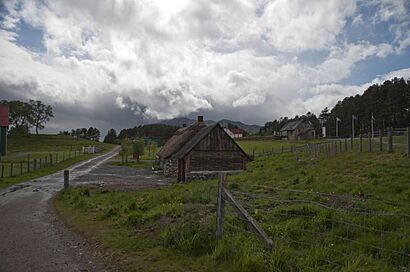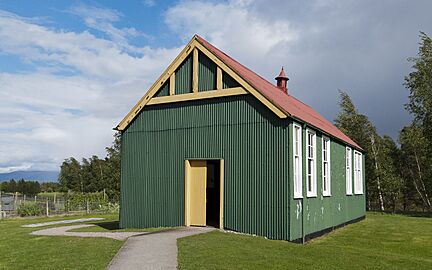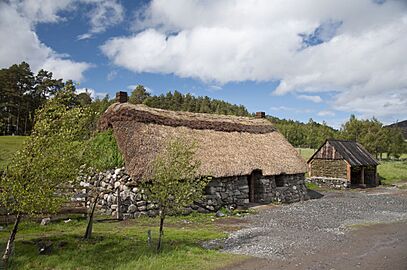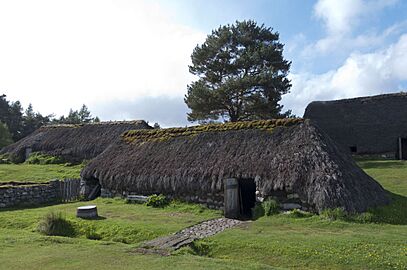Highland Folk Museum facts for kids
 |
|
| Location | United Kingdom |
|---|---|
| Coordinates | 57°04′11″N 4°06′10″W / 57.069708°N 4.102865°W |
| Type | independent museum |
| Website | http://www.highlandfolk.com,%20https://www.highlifehighland.com/highlandfolkmuseum/ |
The Highland Folk Museum is a super cool place to visit in Newtonmore, Scottish Highlands, United Kingdom. It's not just a regular museum; it's an open-air attraction where you can step back in time!
Imagine walking through old villages and seeing how people lived long ago. This museum helps you explore the history and culture of the Scottish Highlands. It's owned by the Highland Council and managed by High Life Highland.
The museum was started in 1935 by a clever lady named Dr Isabel Frances Grant. She wanted to save old Highland items from being lost forever.
Contents
Exploring Highland History
The Highland Folk Museum helps visitors understand what life was like in the Scottish Highlands in the past. It shows how people lived, worked, and played.
How the Museum Started
In 1930, Dr Isabel Frances Grant put together a big exhibition in Inverness. She collected 2,100 old items to show what a national folk museum could be like.
She officially opened the Highland Folk Museum in 1935. She used her own money to buy an old church building on the island of Iona. She called it Am Fasgadh, which means "the shelter" in Scottish Gaelic. Her goal was to "shelter homely ancient Highland things from destruction."
Moving to New Homes
The museum quickly grew too big for its first home. In 1939, it moved to a larger place in Laggan, Badenoch, a village in the central Highlands.
During World War II, it was hard for Dr. Grant to collect new items. There were also fewer visitors because of travel rules. So, in 1943, she bought a big house called Pitmain Lodge in Kingussie. This new spot was much bigger and had three acres of land.
The Highland Folk Museum opened again to the public in Kingussie on June 1, 1944.
What Was in the Collection?
At the Kingussie site, the museum showed many different parts of Highland life from long ago. The collection included:
- Furniture and household items
- Tools for farming and working
- Gear for horses (called horse tackle)
- Cooking and dining things
- Pottery and glass
- Musical instruments
- Sports equipment
- Weapons
- Clothes and fabrics
- Jewellery
- Books, photos, and old papers
The museum also had stories about old beliefs, songs, and handmade items. These included baskets and wooden objects called treen. Dr. Grant even built replica buildings, like an Inverness-shire cottage and a Lewis blackhouse. The museum used live demonstrations to show how things worked.
Changes Over Time
When Dr. Grant retired in 1954, four Scottish universities took over the museum. In 1956, George ‘Taffy’ Davidson became the new curator.
In 1975, the Highland Regional Council started managing the museum. Ross Noble became the curator and began to modernize things. He created new displays and brought back live demonstrations for "Heritage in Action" days.
The Newtonmore Site
In the early 1980s, the museum got a huge 80-acre (32 ha) site in Newtonmore. This new site had four main areas:
- Aultlarie Croft: A working farm that looked like one from the 1930s.
- Balameanach: (Gaelic for middle village) A growing community of buildings moved from other places.
- The Pinewoods: A forest area with walking paths.
- Baile Gean: A recreated Highland village from the early 1700s.
The Newtonmore site opened in 1987. It worked alongside the Kingussie museum until the Kingussie site closed in 2007.
In 2011, High Life Highland took over running the museum day-to-day. A new main building, Am Fasgadh, opened in 2014. In 2015, the museum's collections were officially recognized as very important to Scotland.
What You Can See Today
The museum is divided into three main parts that show different times in Highland history:
- The Pinewoods: A natural forest area.
- 1700s Township: A village showing life in the early 1700s.
- The Open Air Section: Buildings from the 1800s to the mid-1900s.
You might see staff members dressed in old Highland clothes acting out daily life. On some days, you can watch demonstrations of activities like weaving or making rope.
Some buildings at the museum were built there. But many were moved from other places in the Highlands and carefully put back together at the museum!
- In 2000-2001, the museum got a post office building from Glenlivet.
- In 2011, the museum rebuilt a thatched cottage. They used an old photograph from the 1800s of a house that used to be in Grantown-on-Spey.
- In 2012, landowners in Carrbridge gave the museum a croft-house built in the 1920s. Museum staff and students helped move this building 22 miles (35 km) to the museum!






